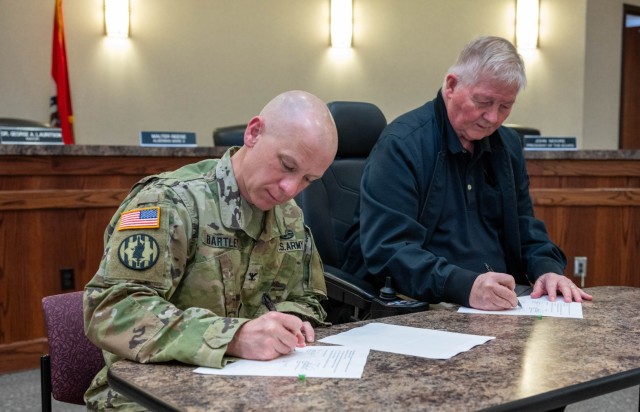
FORT LEONARD WOOD, Mo. — Col. Steven Bartley, U.S. Army Garrison Fort Leonard Wood commander, and Dr. George Lauritson, Central Ozarks Utility and Service Alliance president, signed an Intergovernmental Support Agreement for fire extinguishers Feb. 26 at St. Robert city hall, marking the second IGSA signed this year and saving the installation millions.
“Most people don’t notice the everyday services, such as fire extinguishers, trash collection or street sweeping — until they aren’t getting done,” Bartley said. “IGSAs are an acquisition tool that enable our ability to provide quality installation and base operation services that directly enable collective readiness and enhance the quality of life across the Fort Leonard Wood community.”
IGSAs were established through the National Defense Authorization Act in 2013 as formal public-public partnerships agreements between Army installations and their state or local governments for the provision, receipt or sharing of installation support services, according to the Army’s IGSA website.
Brock Lercher, a project engineer with Fort Leonard Wood’s Plans, Analysis and Integration Office, said CO-USA is an alliance between Pulaski County, Missouri, and the cities of St. Robert and Waynesville and will allow the installation to maintain efficient operations across post.
“Today is a great example of finding local, common-sense solutions that gives time back to the warfighters to focus on their mission, improving lethality,” Bartley said.
PAIO is the lead office to develop IGSAs for Fort Leonard Wood with state, county and local city governments, as well as native American tribes.
According to Lercher, IGSA partnerships accomplish tasks that support military units and families while also generating direct cost savings, cost avoidances and operational efficiencies for both the installation and the community partner.
“Fort Leonard Wood currently has six IGSAs for stray animal control, environmental and natural resources services, confinement services, street sweeping, fire extinguisher inspection and solid waste and recycling services,” Lercher said. “The three most recent IGSAs for solid waste and recycling services, street sweeping and fire extinguisher inspection are projected to save the installation over $320,000 per year and over $3.2 million over the life of these agreements.”
Lercher said IGSAs are, “typically a one-year commitment that can be renewed each year for up to 10 years.”
Mike Vail, PAIO chief, said the fire extinguisher maintenance IGSA will save the installation more than $90,000 a year.
Vail said the fire extinguisher IGSA, “is a modification to the building fire extinguisher maintenance incorporating portable mission critical fire extinguishers” that are used during ammunition transportation, on ranges and inside tactical vehicles.
The fire extinguisher agreement is the second IGSA signed this year. According to Lercher, the first one, signed in January, was years in the making.
“Fort Leonard Wood, in coordination with our partner, the City of Saint Robert, signed an IGSA for trash and recycling services that will become effective April 26,” Lercher said. “This was a culmination of a multi-year and multi-organizational effort that is estimated to save Fort Leonard Wood more than $200,000 annually, and more than $2 million over the course of the 10-year agreement.”

Social Sharing